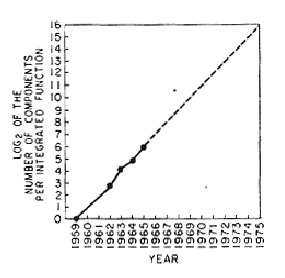CSC/ECE 506 Spring 2012/1b as: Difference between revisions
| Line 1: | Line 1: | ||
==What is Moore's Law?== | ==What is Moore's Law?== | ||
[[Image:TransCount59-75.png|right]] | [[Image:TransCount59-75.png|right]] | ||
Moore's law, named after Gordon Moore, co-founder of Intel, states that the number of transistors that can be placed on an integrated circuit will double approximately every two years<ref>http://www.computerhistory.org/semiconductor/timeline/1965-Moore.html</ref>. The original prediction in 1965 stated a doubling every 12 months, but in 1975, after microprocessors were introduced that were less dense he slowed the rate of doubling to it's current state of two years <ref>http://arstechnica.com/hardware/news/2008/09/moore.ars</ref>. Instead of giving an empirical formula predicting the rate of increase, Moore instead used prose, graphs, and images to convey these predictions and observations to the masses. This in some ways increased the staying power of Moore's law, allowing the industry to use it as a benchmark of success and a measurable determination of their success. Virtually all digital devices are in some way fundamentally linked to the growth set in place by Moore's law.<ref>http://en.wikipedia.org/wiki/Moore's_law</ref> | Moore's law, named after Gordon Moore, co-founder of Intel, states that the number of transistors that can be placed on an [http://en.wikipedia.org/wiki/Integrated_circuit integrated circuit] will double approximately every two years<ref>http://www.computerhistory.org/semiconductor/timeline/1965-Moore.html</ref>. The original prediction in 1965 stated a doubling every 12 months, but in 1975, after microprocessors were introduced that were less dense he slowed the rate of doubling to it's current state of two years <ref>http://arstechnica.com/hardware/news/2008/09/moore.ars</ref>. Instead of giving an empirical formula predicting the rate of increase, Moore instead used prose, graphs, and images to convey these predictions and observations to the masses. This in some ways increased the staying power of Moore's law, allowing the industry to use it as a benchmark of success and a measurable determination of their success. Virtually all digital devices are in some way fundamentally linked to the growth set in place by Moore's law.<ref>http://en.wikipedia.org/wiki/Moore's_law</ref> | ||
==The lesser known second law== | ==The lesser known second law== | ||
Revision as of 05:22, 31 January 2012
What is Moore's Law?

Moore's law, named after Gordon Moore, co-founder of Intel, states that the number of transistors that can be placed on an integrated circuit will double approximately every two years<ref>http://www.computerhistory.org/semiconductor/timeline/1965-Moore.html</ref>. The original prediction in 1965 stated a doubling every 12 months, but in 1975, after microprocessors were introduced that were less dense he slowed the rate of doubling to it's current state of two years <ref>http://arstechnica.com/hardware/news/2008/09/moore.ars</ref>. Instead of giving an empirical formula predicting the rate of increase, Moore instead used prose, graphs, and images to convey these predictions and observations to the masses. This in some ways increased the staying power of Moore's law, allowing the industry to use it as a benchmark of success and a measurable determination of their success. Virtually all digital devices are in some way fundamentally linked to the growth set in place by Moore's law.<ref>http://en.wikipedia.org/wiki/Moore's_law</ref>
The lesser known second law
Also know as Rock's law, this law is a direct consequence to Moore's law in that the cost to produce transistors on a chip may go down, these costs instead flow towards manufacturing, testing, and research and development. The law states that the cost of a semiconductor chip fabrication plant doubles ever four years. Simply put, in order for Moore's law to hold, Rock's law must also hold.<ref>http://en.wikipedia.org/wiki/Rock%27s_law</ref>
Moore's law, past to present

Reviewing data from the inception of Moore's law to the present shows that, consistent to Moore's prediction, the number of transistors on a chip has doubled approximately every 2 years. There are several contributing factors, that had they not been developed, could have slowed or plateaued Moore's law. Some of these are, the invention Dynamic random access memory (DRAM), complementary metal-oxide-semiconductor (CMOS), and the invention of the integrated circuit itself. Moore's law isn't only responsible for making larger and faster chips, but also smaller, cheaper, and more efficient ones as well.
| Processor | Transistor count | Date of introduction | Manufacturer | Process | Area |
|---|---|---|---|---|---|
| Intel 4004 | 2,300 | 1971 | Intel | 10 µm | 12 mm² |
| Intel 8008 | 3,500 | 1972 | Intel | 10 µm | 14 mm² |
| MOS Technology 6502 | 3,510 | 1975 | MOS Technology | 21 mm² | |
| Motorola 6800 | 4,100 | 1974 | Motorola | 16 mm² | |
| Intel 8080 | 4,500 | 1974 | Intel | 6 μm | 20 mm² |
| RCA 1802 | 5,000 | 1974 | RCA | 5 μm | 27 mm² |
| Intel 8085 | 6,500 | 1976 | Intel | 3 μm | 20 mm² |
| Zilog Z80 | 8,500 | 1976 | Zilog | 4 μm | 18 mm² |
| Motorola 6809 | 9,000 | 1978 | Motorola | 5 μm | 21 mm² |
| Intel 8086 | 29,000 | 1978 | Intel | 3 μm | 33 mm² |
| Intel 8088 | 29,000 | 1979 | Intel | 3 μm | 33 mm² |
| Intel 80186 | 55,000 | 1982 | Intel | ||
| Motorola 68000 | 68,000 | 1979 | Motorola | 4 μm | 44 mm² |
| Intel 80286 | 134,000 | 1982 | Intel | 1.5 µm | 49 mm² |
| Intel 80386 | 275,000 | 1985 | Intel | 1.5 µm | 104 mm² |
| Intel 80486 | 1,180,000 | 1989 | Intel | 1 µm | 160 mm² |
| Pentium | 3,100,000 | 1993 | Intel | 0.8 µm | 294 mm² |
| AMD K5 | 4,300,000 | 1996 | AMD | 0.5 µm | |
| Pentium II | 7,500,000 | 1997 | Intel | 0.35 µm | 195 mm² |
| AMD K6 | 8,800,000 | 1997 | AMD | 0.35 µm | |
| Pentium III | 9,500,000 | 1999 | Intel | 0.25 µm | |
| AMD K6-III | 21,300,000 | 1999 | AMD | 0.25 µm | |
| AMD K7 | 22,000,000 | 1999 | AMD | 0.25 µm | |
| Pentium 4 | 42,000,000 | 2000 | Intel | 180 nm | |
| Atom | 47,000,000 | 2008 | Intel | 45 nm | |
| Barton | 54,300,000 | 2003 | AMD | 130 nm | |
| AMD K8 | 105,900,000 | 2003 | AMD | 130 nm | |
| Itanium 2 | 220,000,000 | 2003 | Intel | 130 nm | |
| Cell | 241,000,000 | 2006 | Sony/IBM/Toshiba | 90 nm | |
| Core 2 Duo | 291,000,000 | 2006 | Intel | 65 nm | |
| AMD K10 | 463,000,000 | 2007 | AMD | 65 nm | |
| AMD K10 | 758,000,000 | 2008 | AMD | 45 nm | |
| Itanium 2 with 9MB cache | 592,000,000 | 2004 | Intel | 130 nm | |
| Core i7 (Quad) | 731,000,000 | 2008 | Intel | 45 nm | 263 mm² |
| Six-Core Xeon 7400 | 1,900,000,000 | 2008 | Intel | 45 nm | |
| POWER6 | 789,000,000 | 2007 | IBM | 65 nm | 341 mm² |
| Six-Core Opteron 2400 | 904,000,000 | 2009 | AMD | 45 nm | 346 mm² |
| 16-Core SPARC T3 | 1,000,000,000 | 2010 | Sun/Oracle Corporation|Oracle | 40 nm | 377 mm² |
| Core i7 (Gulftown) | 1,170,000,000 | 2010 | Intel | 32 nm | 240 mm² |
| 8-core POWER7 | 1,200,000,000 | 2010 | IBM | 45 nm | 567 mm² |
| z196 | 1,400,000,000 | 2010 | IBM | 45 nm | 512 mm² |
| Dual-Core Itanium 2 | 1,700,000,000 | 2006 | Intel | 90 nm | 596 mm² |
| Tukwila | 2,000,000,000 | 2010 | Intel | 65 nm | 699 mm² |
| Core i7 (Sandy Bridge-E) | 2,270,000,000 | 2011 | Intel | 32 nm | 434 mm² |
| Nehalem-EX | 2,300,000,000 | 2010 | Intel | 45 nm | 684 mm² |
| 10-Core Xeon Westmere-EX | 2,600,000,000 | 2011 | Intel | 32 nm | 512 mm² |
References
<references/>